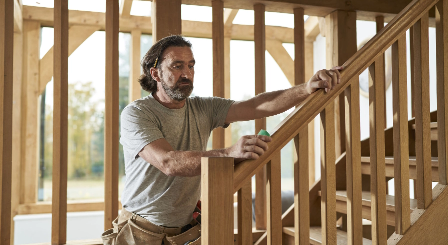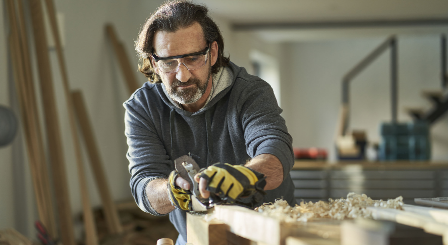Trade business risks and hazards
For tradespeople, risks comes in many shapes and styles. From power tools to ladders and from dust particles to paint fumes, there's lots of potential hazards to be aware of.
Here, AXA examines the most common risks to tradespeople, and some of the best ways to avoid the most hazards where possible.
What is a risk assessment?
As a business owner, it’s up to you to spot and highlight the risks present within your workplace. The first step towards identifying and controlling the possible risks to your trades business is to perform a risk assessment.
It might sound pretty formal, but it doesn’t falways need to be. A risk assessment simply involves working out any ways in which your business operations could potentially cause harm or injury to either yourself, an employee or a member of the public, then planning the steps you’ll take to mitigate those risks. It’s an important step in protecting your team, your customers and their property, while ensuring you’re complying with your responsibilities as an employer.
If your business has under five employees, you don’t need a formal written risk assessment, although it might still be a good exercise to keep your business safe. However, if you employ five staff or more full time, then your risk assessment should be a written health and safety policy that you can use to train your staff and prevent accidents.
Hazards and risks
It may help to split your risk assessment into hazards and risks and to know the difference between the two.

Hazards
Hazards are objects or situations with the potential to cause harm. These could be items like tools, ladders or chemicals, or processes like lifting and moving stock or working at height.
Identify your hazards by examining each aspect of your business practices and asking yourself: what activities, processes, tools or substances could insure someone or harm their health? Check any accident records you might have, check manufacturer’s instructions or warning labels on any products you use and visit the Health and Safety Executive.

Risks
Risk, on the other hand, is about assessing how likely things are to go wrong and how serious the implications might be if they do.
Risk is a part of everyday life and it’s impossible to eliminate every risk present in your business. But as a responsible business owner, it’s your responsibility to do everything ‘reasonably practical’ to control the risks your business presents.
Common hazards for shop owners
While the hazards will vary from trade to trade, these are some of the most common ones that come up whether you’re a painter or a plumber, a carpenter or a contractor.
Slips and trips
Slips or trips are one of the most common types of accident for most occupations, including the trades businesses. Whether you’re using power tools, working with water, or have ladders about, it’s easy for slips and trips to occur.
Avoid slips and falls:
- Ensure spillages are dealt with promptly
- Let clients or other employees know about any wet surfaces which may be slippery
- Keep walkways as clear as possible of trip hazards like cords and cables, and keep communication with employees and staff of any cables in use, for example from a lawn mower or hedge trimmer
Manual handling
Lifting, pushing and pulling is often part and parcel of any type of occupation and according to the HSE, 18% of the most common workplace accidents were caused by handling, lifting or carrying in 2020-21.
The most common injuries associated with manual handling are musculoskeletal disorders (MSDs), including pain or injury to arms, legs and joints. Back and shoulder strains are very common too, as well as repetitive strain injuries (RSI).
Manual handling injuries can occur almost anywhere in the workplace, but heavy manual labour, awkward postures, repetitive movements of arms, legs and back or previous/existing injury can increase the risk.
However, many manual handling type injuries can be caused by smaller tasks like packing, typing, cleaning, or moving supplies.
For a full rundown of the best manual handling practices, follow AXA’s guide to manual handling here.
The best manual handling techniques are:
- Think before you lift
- Use a safe lifting position
- Get a good grip
- Keep the load close to your waist
- Don’t lift with your back
- Avoid twisting
- Look up
- Move smoothly
- Don’t lift more than necessary
- Put it down, then adjust
Power tools
Large power tools that involve cutting, shredding, or chopping have inherent risk due to the blades used and the electricity that power them. According to HSE, woodworking is the only industry where machinery accidents cause more injuries than slips and trips with 25% of these are classed as major injuries.
There can be a lot of risk to manage when using heavy equipment like this, so consider taking a course if you’re not confident.
Use power tools safely:
- Tools should be always be used in accordance with manufacturer instructions and guidance
- Look out for CE certification, which confirms that a tool meets European safety standards
- Make sure there are clear operating instructions, and that anyone who uses the tool is familiar with them
- Wear safety equipment where relevant – if using a saw, for example, then goggles will be essential
- Ensure tools are properly maintained to reduce risk of malfunctions
Hand and arm vibration
If you regularly use tools that have a vibrations, you may be more likely to develop Hand Arm Vibration Syndrome (HAVS) or Carpal Tunnel Syndrome (CTS). While this sounds niche, according to the HSE, nearly 2 million workers are at risk of developing HAVS.
Reduce this risk:
- Reduce vibration exposure by reducing the vibration transmitted to the hand
- Reduce vibration exposure by reducing the time spent holding vibrating equipment or work-pieces
- Understand exposure using the HSE vibration calculator
Hearing damage
Many common tools of the trade can be quite loud and consistent exposure to the loud noises from machinery can contribute to hearing damage such as tinnitus or deafness. According to HSE, noise-induced hearing loss is the second most common reason for employers’ liability insurance claims for occupational health.
Protect your ears:
- Wear hearing protection such as ear defenders when using loud machinery
- Research and use the quietest machinery possible
- Get regular hearing checks to catch any loss in hearing capability early
- Create a work pattern that doesn’t create long-term or consistent exposure to loud noise
Skin damage
A 2019 report by HSE found that in the UK, roughly 3% of plumbers experience problems with skin diseases. Tradespeople can be exposed to a variety of chemicals and materials that damage or dry out their skin – even over-washing them can lead to issues.
Once the skin is damaged or cracked, bacteria can get in and lead to bigger issues.
Keep your skin healthy:
- Wear protective gloves as often as possible when using materials that could irritate your skin
- Wash your hands thoroughly after handling any chemicals using a good quality hand soap
- Moisturise your hands regularly after washing them so that they don’t end up dry or inflamed
- Check your skin regularly for any signs of damage and deal with issues immediately as they arise
Working from heights
Whether you’re up a ladder to organise boxes in a stock room, or are using step ladders to decorate the shop for a themed display, sometimes it is a necessity for shop owners to work from high up. Working from heights comes with extra falling risks that are worse than your average trip or slip.
While it may feel unlikely for a professional who is accustomed to working from heights to fall, HSE reported that from 2021-2022, falling from heights as the leading cause of fatal accidents in the workplace.
Ladder safety tips:
- Always check the ladder before using and ensure it is not bent or damaged in anyway
- Only use the ladder on firm, level ground out of the way from windows, doors and other hazards
- Ensure the ladder is secured – you can do this by securing it to a suitable point or using a ladder stability device
Chemical exposure and inhalation
Whether it’s old lead-based paints, walls with asbestos in them, insulation fibres, or just dust in general, there’s a lot of unwanted fumes and particles you can end up inhaling as a tradesperson. According to HSE, asbestos alone kills around 20 tradespeople every week because of past exposure.
Luckily, with preparation and the right equipment a lot of the inhalation and chemical contact risks can be reduced.
Prevent and reduce chemical exposure:
- Reduce dust levels wet-cutting where relevant or removing paint and debris with a damp cloth. Water helps prevent particles from going airborne and spreading around more
- Use on-tool extraction where possible to control dust and particles quickly
- Clean as you go in order to minimise the risk of disturbing dust and particles that may be hazardous to your health
- Use PPE when ever possible. To ensure it is as effective as possible, get one that fits your face properly and that you wear it correctly. Check the level of protection that the mask gives and be sure that it is appropriate for the work you are doing
- Work in well ventilated areas as often as possible when mixing, cutting or otherwise exposed to excess fumes and dust
Electric shock
Contact with electricity or electrical discharge is in the top 5 causes of fatal injuries in the construction industry and accounted for 6% of fatal injuries from 2018 – 2022. While it’s lower than other safety risks here, it’s still one that should be taken seriously. Electric shocks can also lead to other injuries such as falling from a height.
A few tips for preventing electrical injury:
- Unless told explicitly otherwise, treat all cables as if they are live
- Wear protective clothing and gloves where relevant
- Shut off the power and water as needed to ensure you can work safely
- Diligently check for wires in walls, ceilings, floors, the ground and other workspaces before carrying out a job so that you don’t accidentally encounter one
- Immediately stop using any electrical equipment that seems faulty and have it checked by a professional
Flying debris and moving objects
There’s a lot of moving parts when you’re on a job site – sometimes literally. Falling objects or flying debris can pose a huge safety risk, especially if you’re working in a cramped space. In fact, according to HSE, this accounts for roughly 10% of all workplace accidents.
Keep safe on the job:
- Wear a hardhat when walking around a job site – particularly one that has people working from a height who could drop things
- Wear eye protection to ensure that debris does fly into your eye
- Put up signs where relevant informing other works and the public to avoid areas where there is a risk of falling objects
How to protect your trades business
No matter how careful you are, you can’t eliminate every hazard and accidents can always happen. That’s why business insurance from AXA can help protect you if things do go wrong.
At AXA, we give you the freedom to style your insurance to meet your needs. You can pick and choose covers and build an insurance policy that protects your business, your employees if you have any, and any specialist equipment you have.
Main covers for trade businesses:
Here’s a quick summary of cover types that trade businesses may want to consider. What you need and what you’re eligible for will depend on the nature of your trade business. To get the full details for any of these cover types, click on the link within the description or use our search bar to look up that type of cover.

which protects your business from the consequences of your or your employees actions where a third party is injured or their property damaged.
Employers’ liability insurance
which is a legal requirement for any business with employees and protects your business if your employees are injured or fall ill as a result of working for you.
Professional indemnity insurance
client claiming you’ve given them bad advice, services or design? Cover the legal costs and expenses incurred in your defence – as well as damages and costs that might be awarded.
which protects your own tools and equipment in the case of loss or theft.
Van insurance for tradespeople
you’ll get accident recovery, roadside repairs and a guaranteed courtesy van – and cover for little things like wrong fuel, lost keys and satnavs.
Work hard, insure easy
Running a business is hard work. That’s why we’re doing all we can to make your insurance a bit easier. From helping you tailor your policy to your unique business needs, to taking the guesswork out of finding business insurance, find out what we’re doing to help small businesses.
All links are checked and valid at time of publishing, 20 November 2023.
